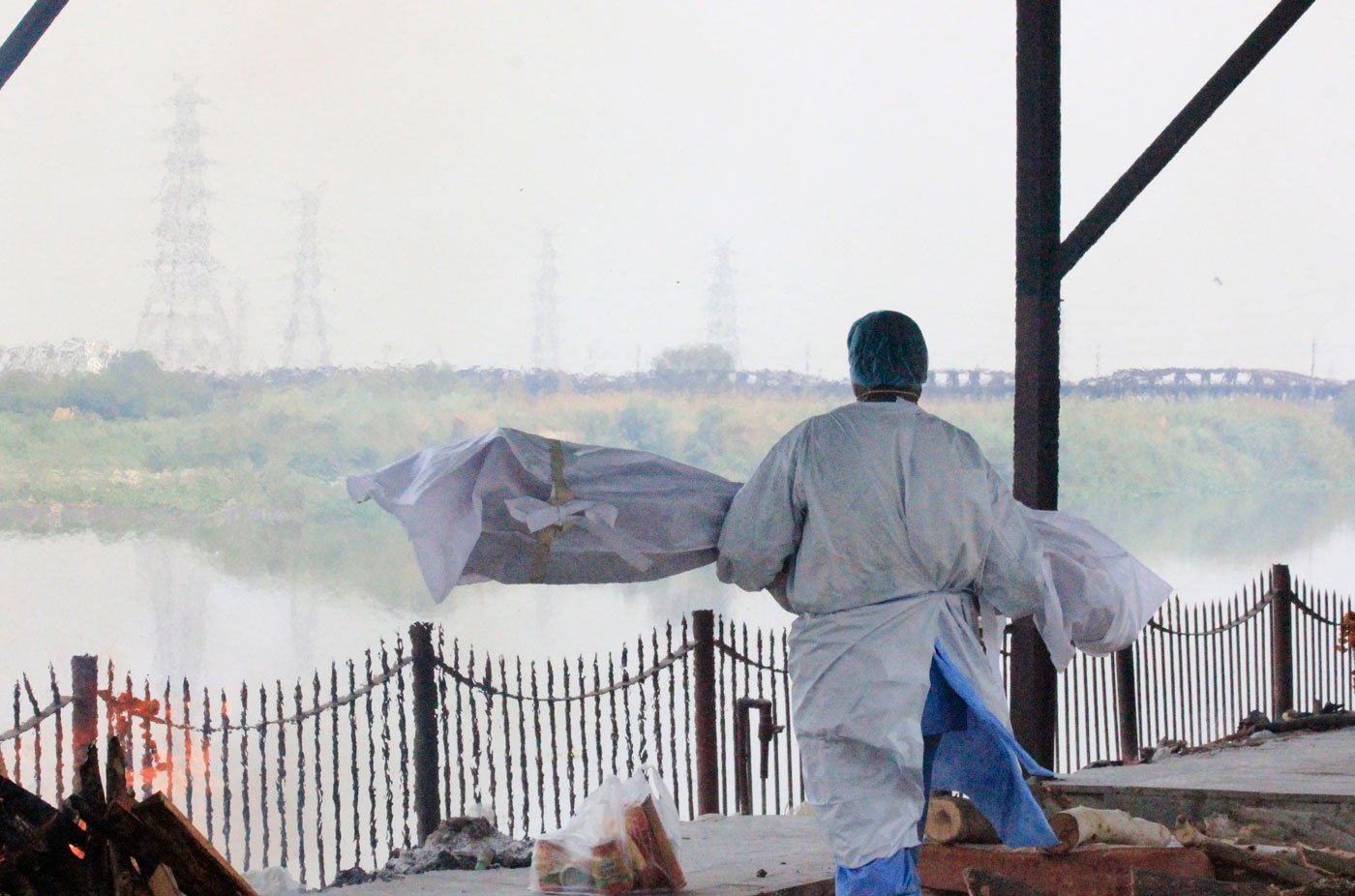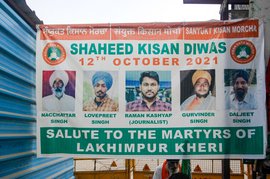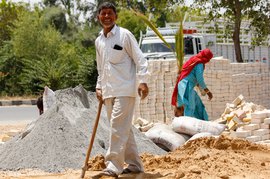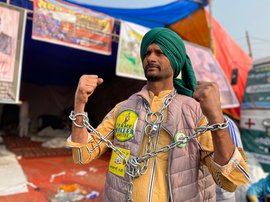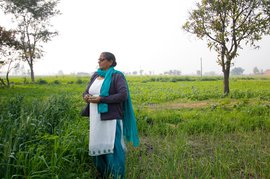When Harinder Singh asked his coworker Pappu to prepare the last two bodies for cremation on May 4, the last thing he expected was to startle his colleagues. His choice of words was unusual.
Harinder said: “ Do launde lete hue hain [Two boys are lying there]”. The initial surprise of his colleagues gave way to amused laughter when they saw he was being earnest. It was a rare moment of relief in the drudgery of their jobs at Nigam Bodh Ghat – the busiest crematorium in New Delhi.
But Harinder felt he needed to explain himself to me. He was eating dinner with his coworkers in a small room near the crematorium's furnaces. He took a breath – he was lucky to be breathing in the hellish Covid pandemic – and said, “You call them bodies. We call them launde [boys].”
“Everyone being brought here is someone’s son or daughter, just like mine,” added Pappu. “It is painful to send them to the furnace. But we have to do it for their soul, don’t we?” Over 200 bodies were being cremated at Nigam Bodh every day for over a month – in CNG furnaces and on open pyres.
That day, on May 4, 35 bodies were cremated in the CNG furnaces at Nigam Bodh Ghat. The number was a little less than the daily average of 45-50 since the first week of April, when the second Covid wave was gripping Delhi. But before the pandemic, the crematorium’s CNG furnaces handled only about 100 bodies a month.
At the entrance to the Ghat, on the banks of Yamuna river near Kashmere Gate in Delhi, is a large mural. It says: “Thank you for bringing me here. From here, I will proceed alone.” But when Covid-19 took over the national capital in April-May this year, the dead were not alone – they may have found a friend on the journey to the afterlife.
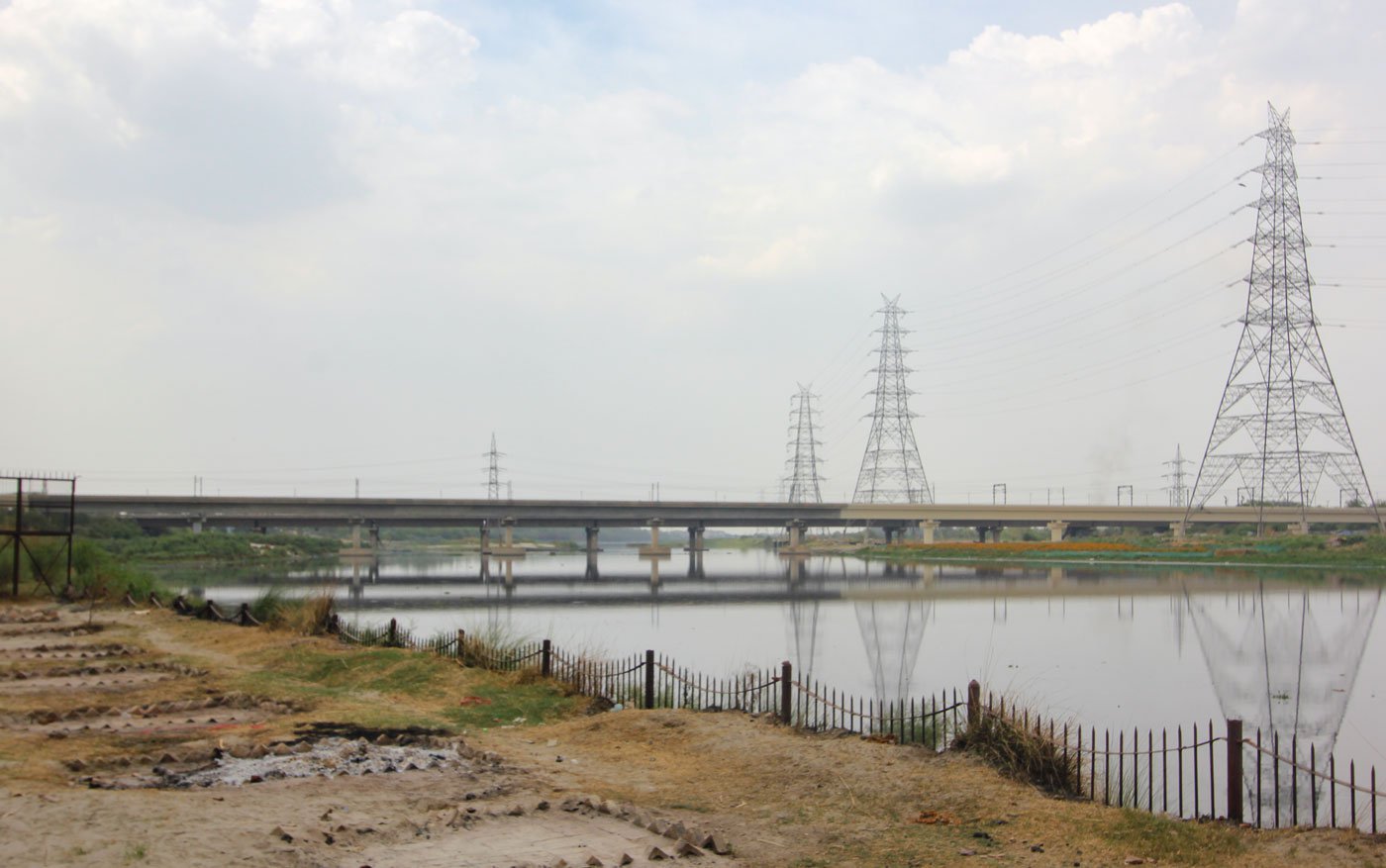
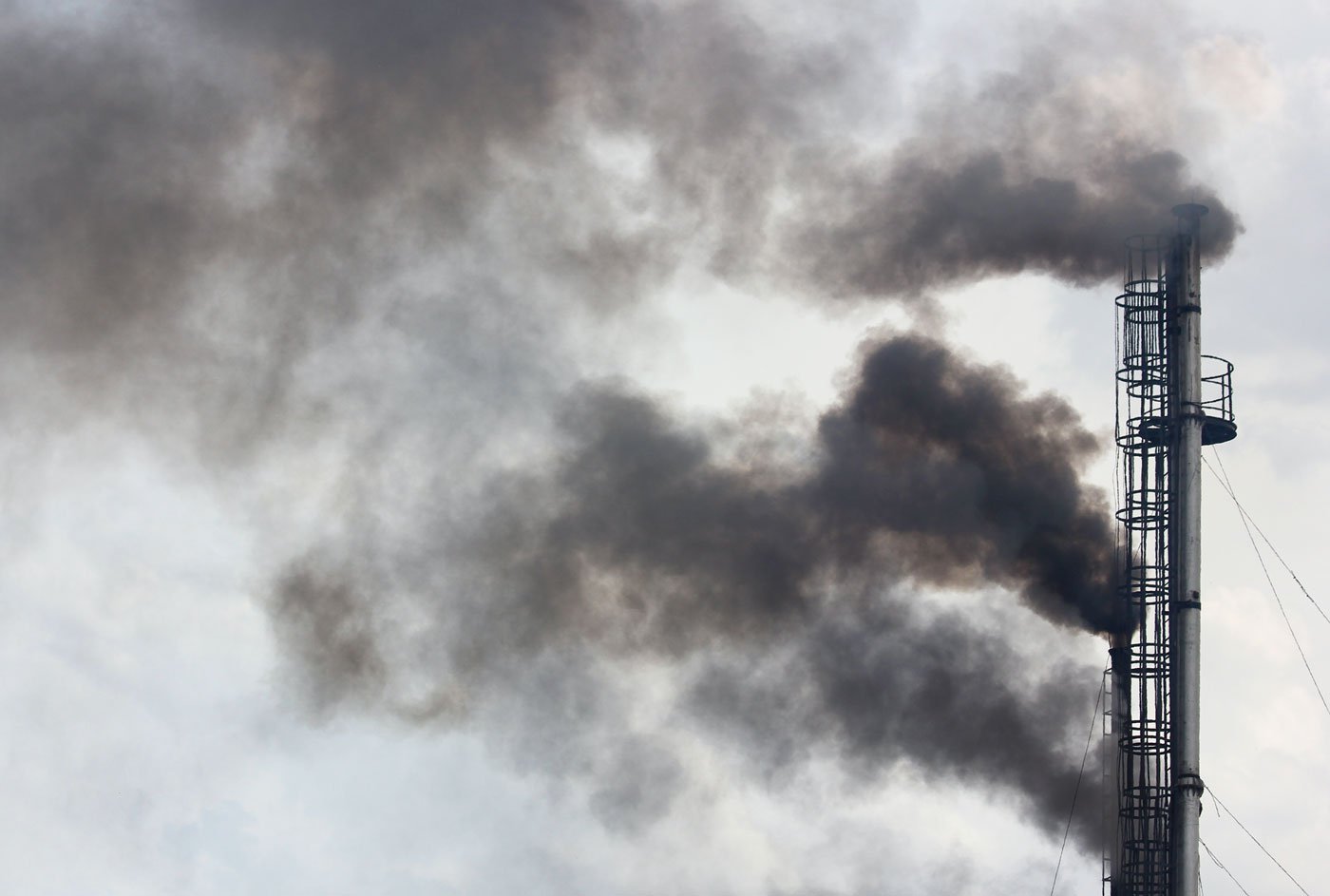
Left: New spots created for pyres at Nigam Bodh Ghat on the banks of the Yamuna in Delhi. Right: Smoke rising from chimneys of the CNG furnaces
Walking in, a noxious smell of burning corpses combined with odours from the polluted Yamuna was pervading the air, penetrating through my double mask. Nearly 25 pyres were burning in the distance, close to the river. There were more along the path, on both sides of a narrow passage leading to the river bank – five pyres on the right and three on the left. And even more bodies were waiting their turn.
A makeshift crematorium created by levelling an empty ground on the premises, had 21 new spots – but not enough. In the middle stood a young tree – its leaves charred by the flames of burning bodies – as if recording the Kafkaesque quagmire that the country had been pushed into.
The workers knew something about that too. Inside the halls with the CNG furnaces, where they worked, people were on their feet, walking about, crying, grieving and praying for the soul of the deceased. The waiting areas of the building, lit by flickering tubelights, were hardly being used.
Of the six furnaces there, “half were installed only last year [2020], after the corona-infected bodies started piling up,” Pappu said. Since the outbreak of Covid-19, the the CNG furnaces cremated only the bodies of people who died from the infection.
When it was the turn of a body for cremation, the persons accompanying it or hospital staffers or the cremation workers, brought it to the furnace. Some bodies – luckier than the others – were shrouded in white cloth. The others, packed in white plastic sacks, were brought straight from the ambulance. Some were brought on stretchers, others were carried into the building.
The cremation workers then lifted the body onto a platform with wheels, set on a rail going into furnace. The next part required quick action – once the body was pushed into the furnace, the workers had to rapidly pull out the platform and shut and bolt the furnace door. Tearful family members watched their loved ones disappear into the furnace, while dark clouds of smoke rose high from the big chimney.
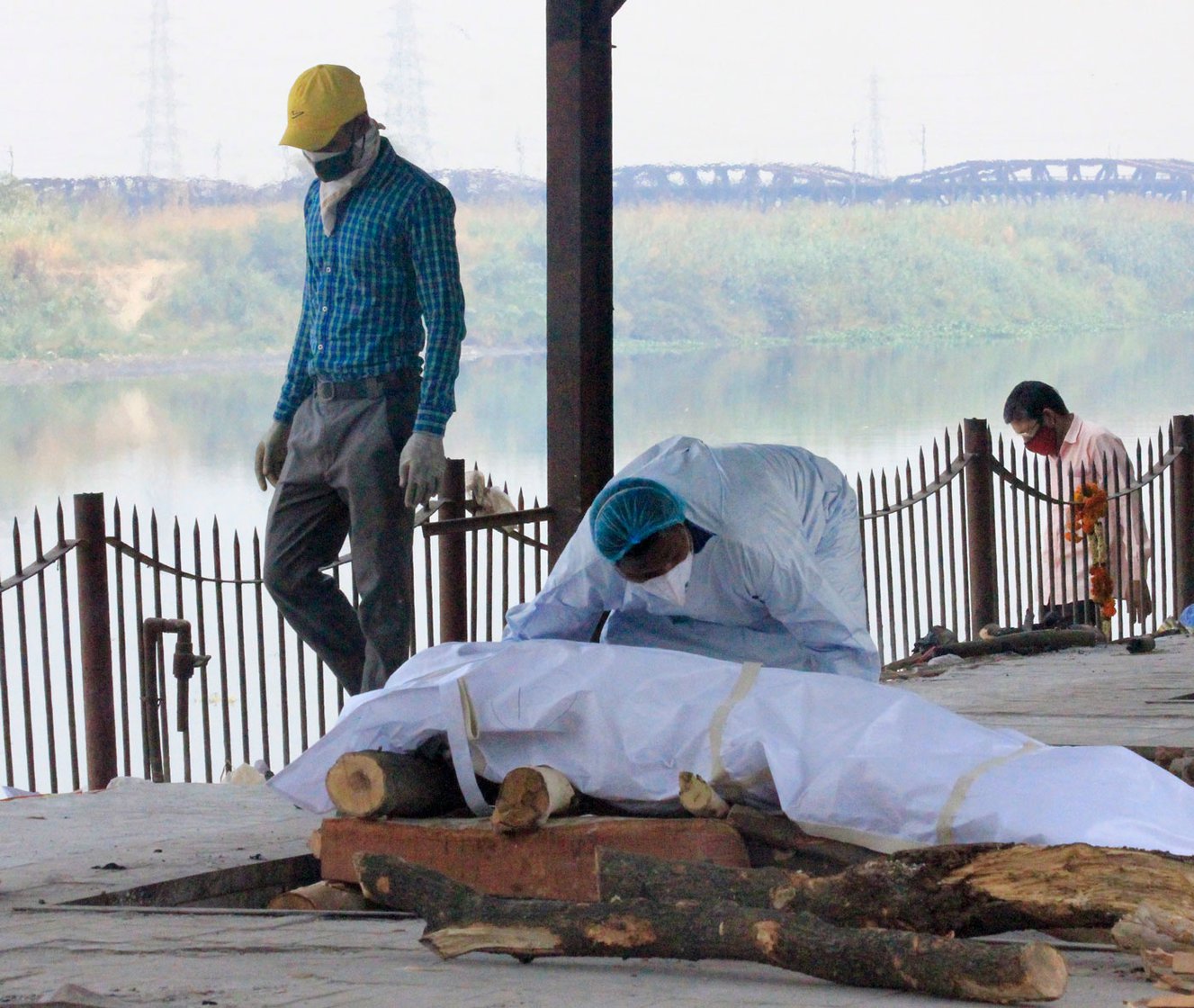
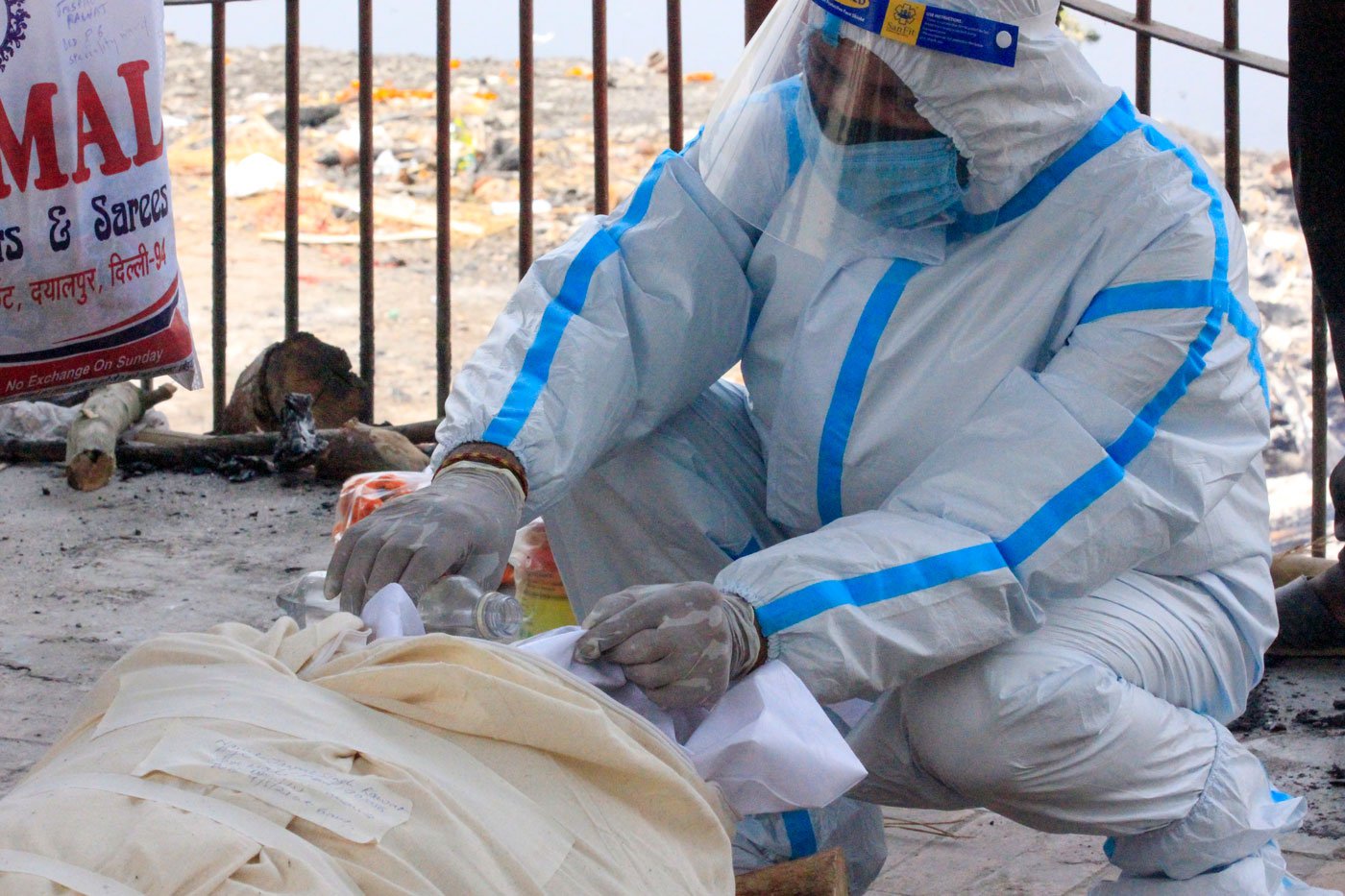
Left: A body being prepared for the funeral pyre. Right: Water from the Ganga being sprinkled on the body of a person who died from Covid-19
“The first body of the day takes two hours to completely burn,” Pappu told me, “because the furnace takes time to heat up. The bodies after that take an hour and half each.” Each furnace can cremate 7-9 bodies in a day.
The furnaces at Nigam Bodh Ghat are being managed by four workers – all belonging to the Kori community, a scheduled caste in Uttar Pradesh. The senior most, Harinder, 55, is originally from Ballia district in UP. He has worked there since 2004. Pappu, 39, who joined in 2011, is from Soron block in UP’s Kanshiram Nagar district,. The other two are newer at the job. Raju Mohan, 37, is also from Soron, and Rakesh, 28, is from Bahuvan Madar Majha
village in Gonda district.
They were each putting in 15-17 hours every day in April-May – from 9 a.m. to after midnight – risking their lives to manage the load. Even if they could evade the virus, the 840°C heat from the furnace might have dissolved them. “After switching it off at night, if we kept a body inside, then in the morning all we would get is ash,” said Harinder.
And they were working without any time off. “How could we [take a break], when we do not even get time to drink water or tea?” said Pappu. “It would be chaos here if we went away even for a couple of hours.”
Yet none of them is employed as a permanent worker. Nigam Bodh Ghat is a municipal crematorium managed by a charitable organisation called Badi Panchayat Vaishya Beese Agarwal (referred to as ‘ sanstha ’ by people in the area).
The organisation pays Harinder Rs. 16,000 per month. It works out to Rs. 533 a day and Rs. 66 for a body if he cremates eight in a day. Pappu is paid Rs. 12,000 per month, while Raju Mohan and Rakesh get Rs. 8,000 each. “The sanstha had promised to increase our salaries. But they did not tell us by how much,” Harinder told me.
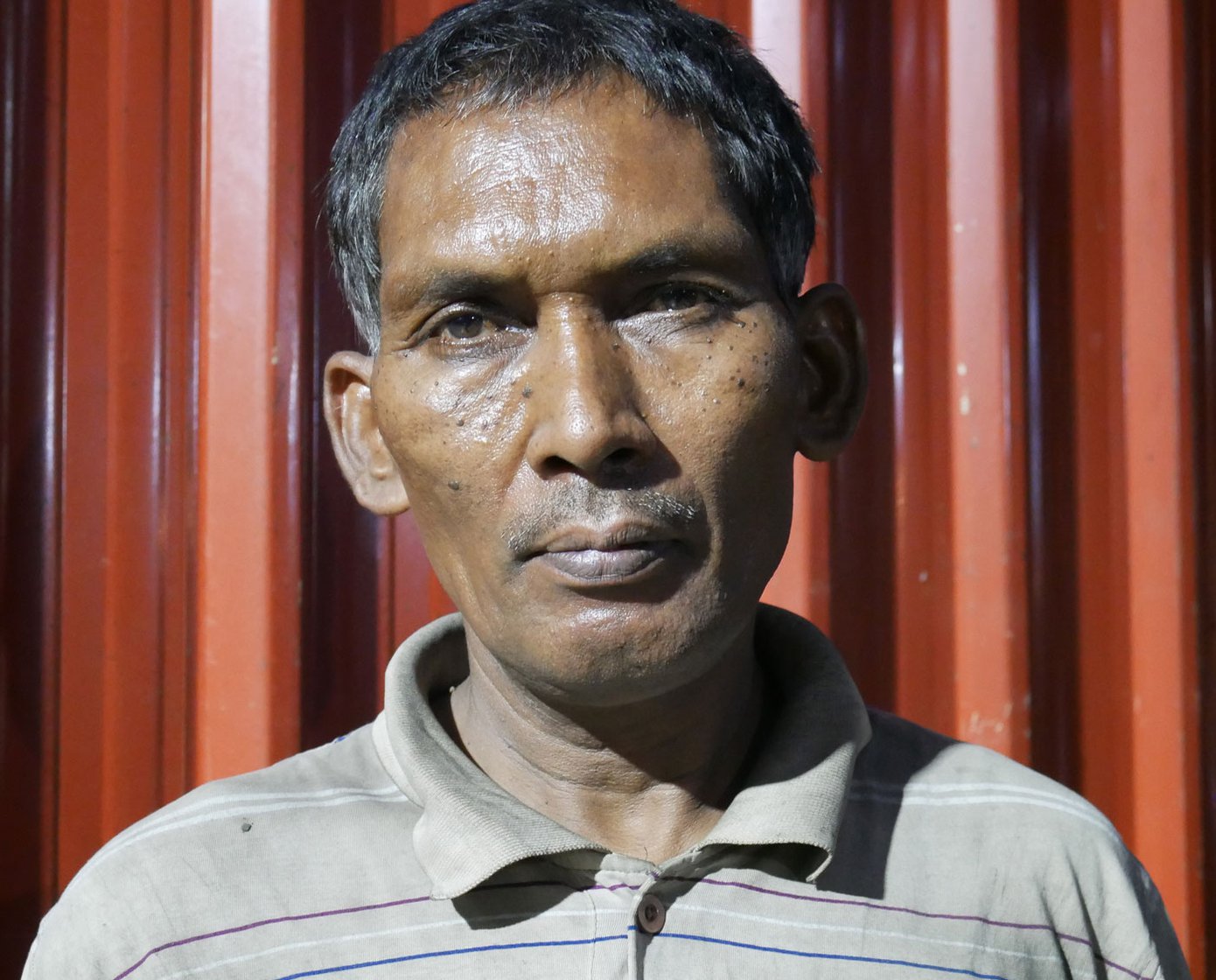
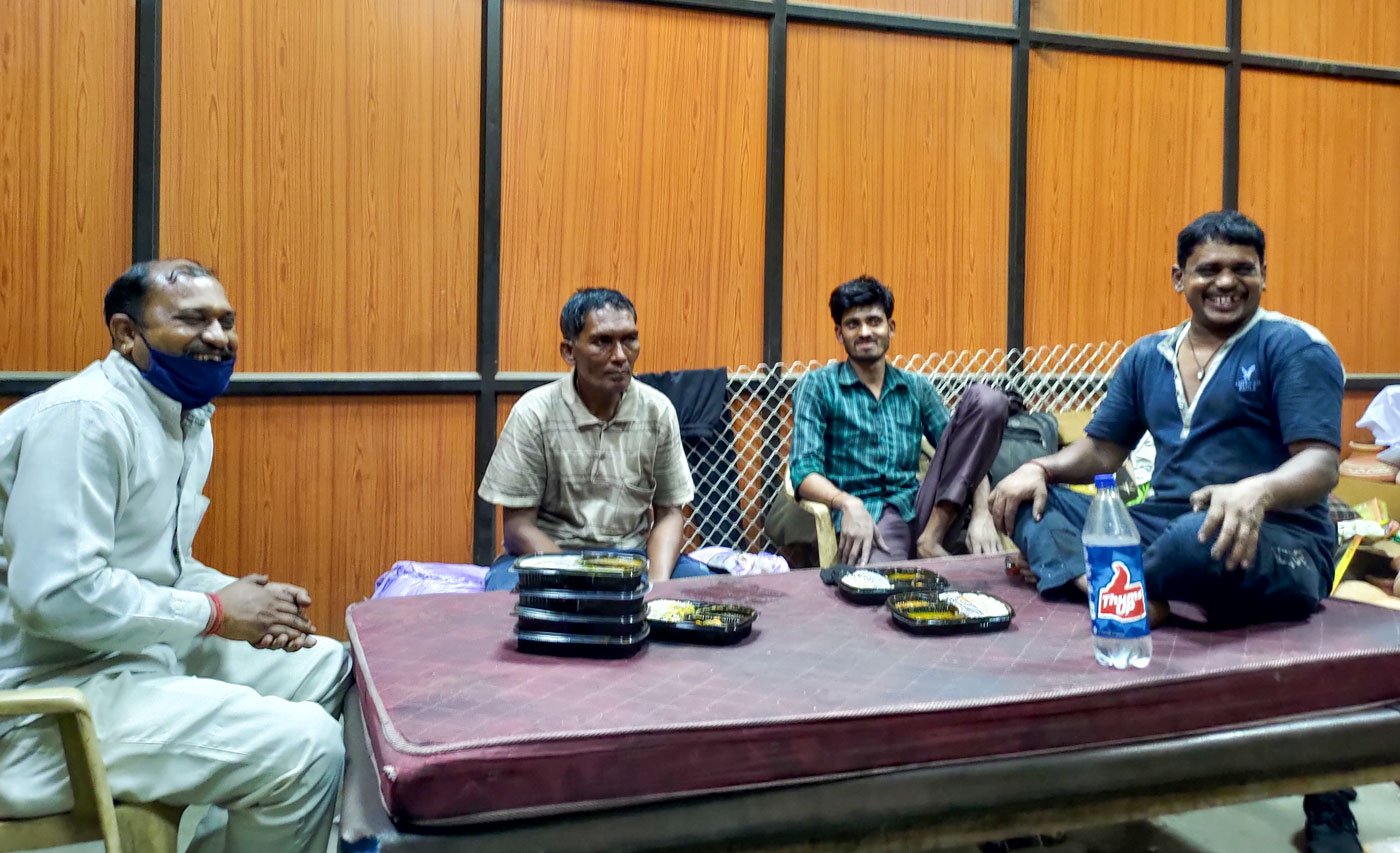
Left: Harinder Singh. Right: Raju Mohan, Harinder, Rakesh and Pappu share a light moment while having dinner in the room near the furnace
The sanstha , however, despite charging Rs. 1,500 for a cremation (Rs. 1,000 before the pandemic), did not appear to be planning a pay rise. Its general secretary Suman Gupta told me: “If we increased their salaries, the organisation would have to give the increased amount throughout the year.” They are given “incentives” he added.
He could not have meant the small room where the workers were eating dinner. Just five metres from the furnace, heat turned the room into a sauna in summer. So Pappu went out and brought cold drinks for everyone. It cost him more than Rs. 50 – the value of a body he burned that day.
Pappu told me later that it takes nearly 14 kilos of CNG to burn one cadaver. “The first body requires as much gas as two domestic cylinders used in our kitchens. The bodies later need less – one to one-and-half cylinders.” In April, Nigam Bodh’s CNG furnaces cremated 543 bodies, said Gupta, and the sanstha’s CNG bill was Rs. 3,26,960 that month.
The workers speed up the burning process by lifting open the furnace door and joggling the body with a long stick, pushing it deeper into the machine. “If we don’t do that, it will take at least 2-3 hours for a body to completely burn,” said Harinder. We have to finish early so that we can save CNG. Otherwise the sanstha will bear the loss”
Despite their effort at saving the organisation's costs, it has been two years since the cremation workers’ salaries were increased. “We are cremating Covid-inflicted bodies now, risking our lives,” said Pappu, unhappy about not being paid more. “We are told, ‘The sanstha runs on charity and donations, so what can be done?’” added Harinder. Literally, nothing had been done for them.
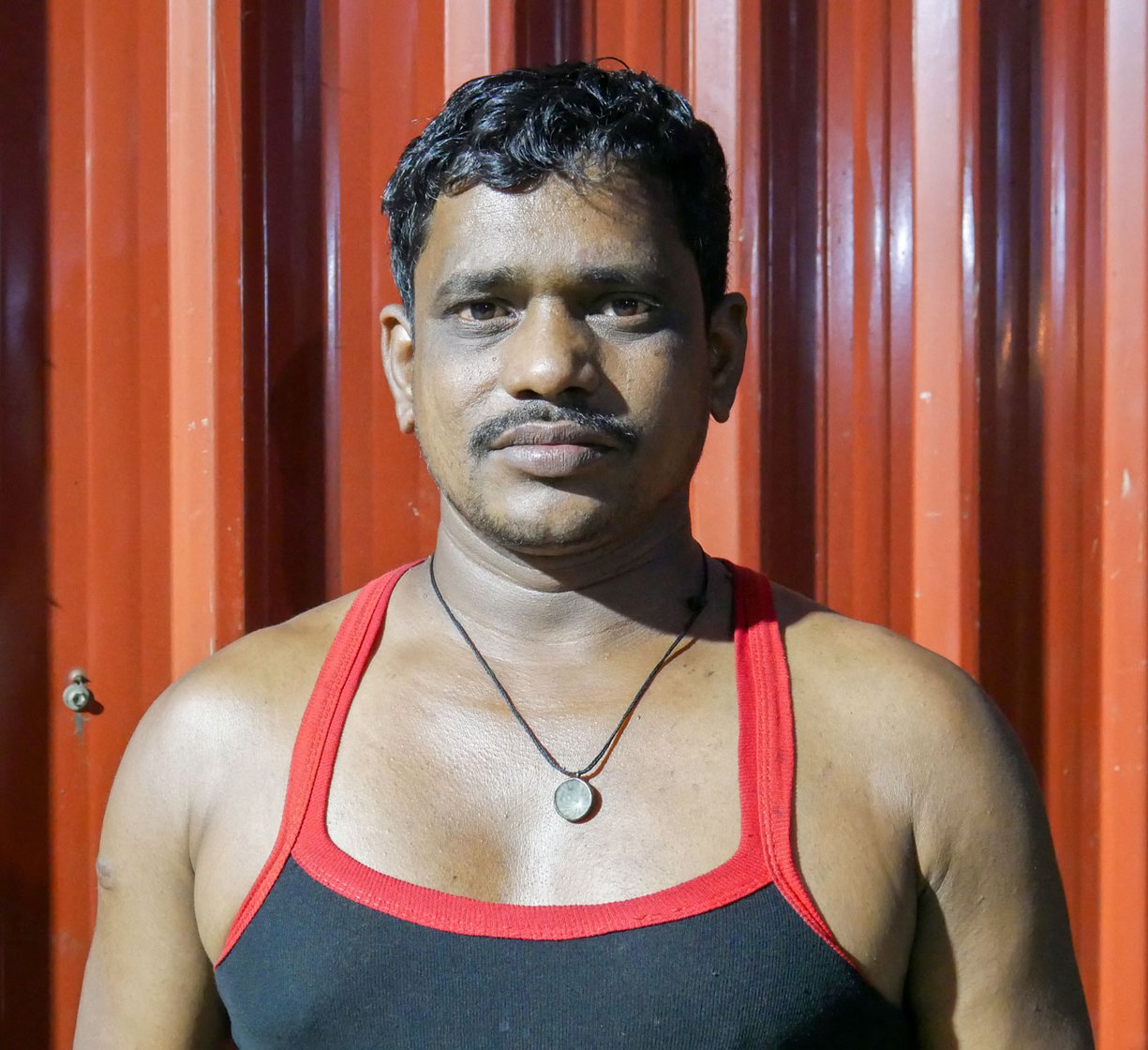
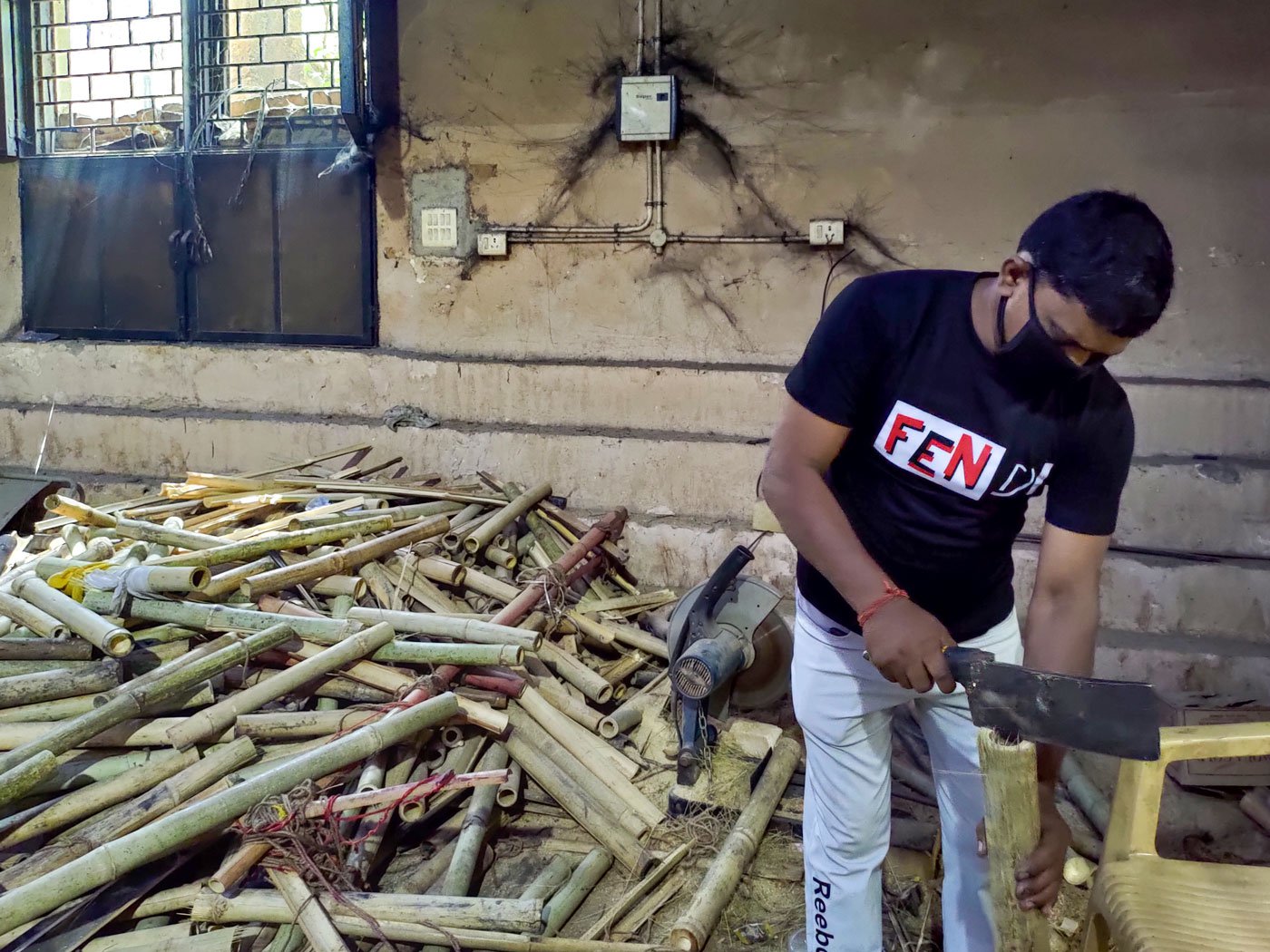
Pappu has worked at Nigam Bodh Ghat since 2011. Cutting bamboo into pieces to set up a pyre inside the CNG furnace is one of his many tasks
They are not even fully vaccinated. Pappu and Harinder received their first vaccine dose earlier in the year when frontline workers were being inoculated. “I could not go for the second as there was no time. I was busy in the crematorium,” said Pappu. “When I got the call, I asked the person from the vaccination centre to give my vaccine to someone else.”
Earlier that morning, Pappu saw a bin near a furnace covered with personal protective equipment (PPE) kits left behind by visitors the previous days. Even though the visitors were told to dispose them in the large bin outside, many had dumped the PPEs in the hall. Pappu pulled it all out with the help of a stick and dragged it outside. He himself was not wearing a PPE nor did he have any gloves on.
Pappu said the unbearable heat near the furnaces made it impossible to wear the PPE. “Also, chances of the PPE catching fire are high as the flames from inside the furnace escape through the door sometimes, when a body’s stomach bursts. Taking the PPE off would take time and could end up killing us,” he explained. Harinder added: “Wearing the kit chokes me and leaves me breathless. Do I have a death wish or what?”
Their only protection was a mask, which they had been wearing for days. “We are worried about being infected by the virus. But this is a crisis that we cannot ignore,” said Pappu. “People are already sad, we cannot leave them in despair.”
The risks do no end there. Once, while cremating a body, Pappu’s left arm was scalded by the flames, leaving a scar. “I felt it, it hurt. But what to do about it.” An hour before I met them, Harinder had been hurt. “The door hit my knee when I was closing it,” he told me.
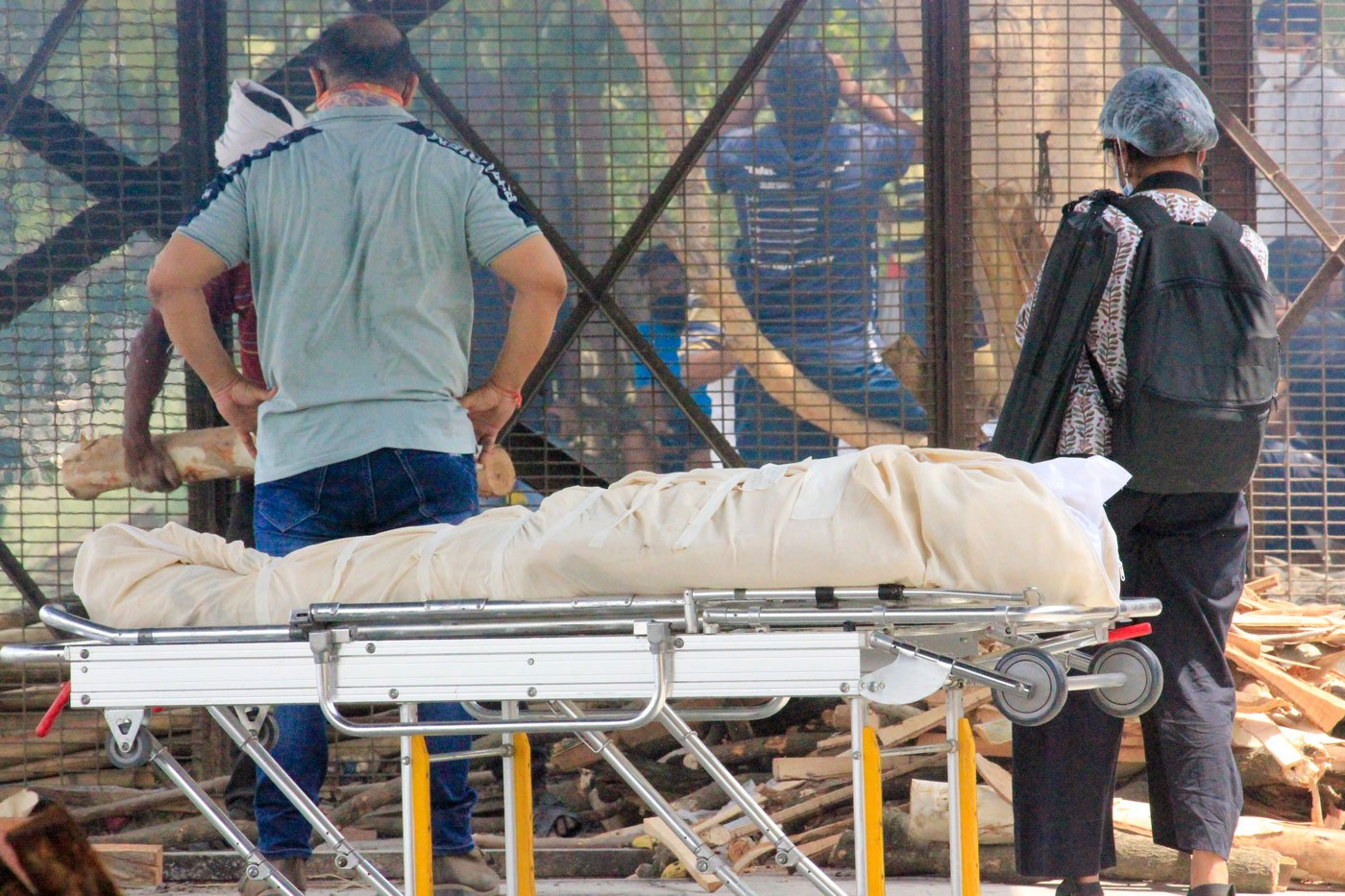
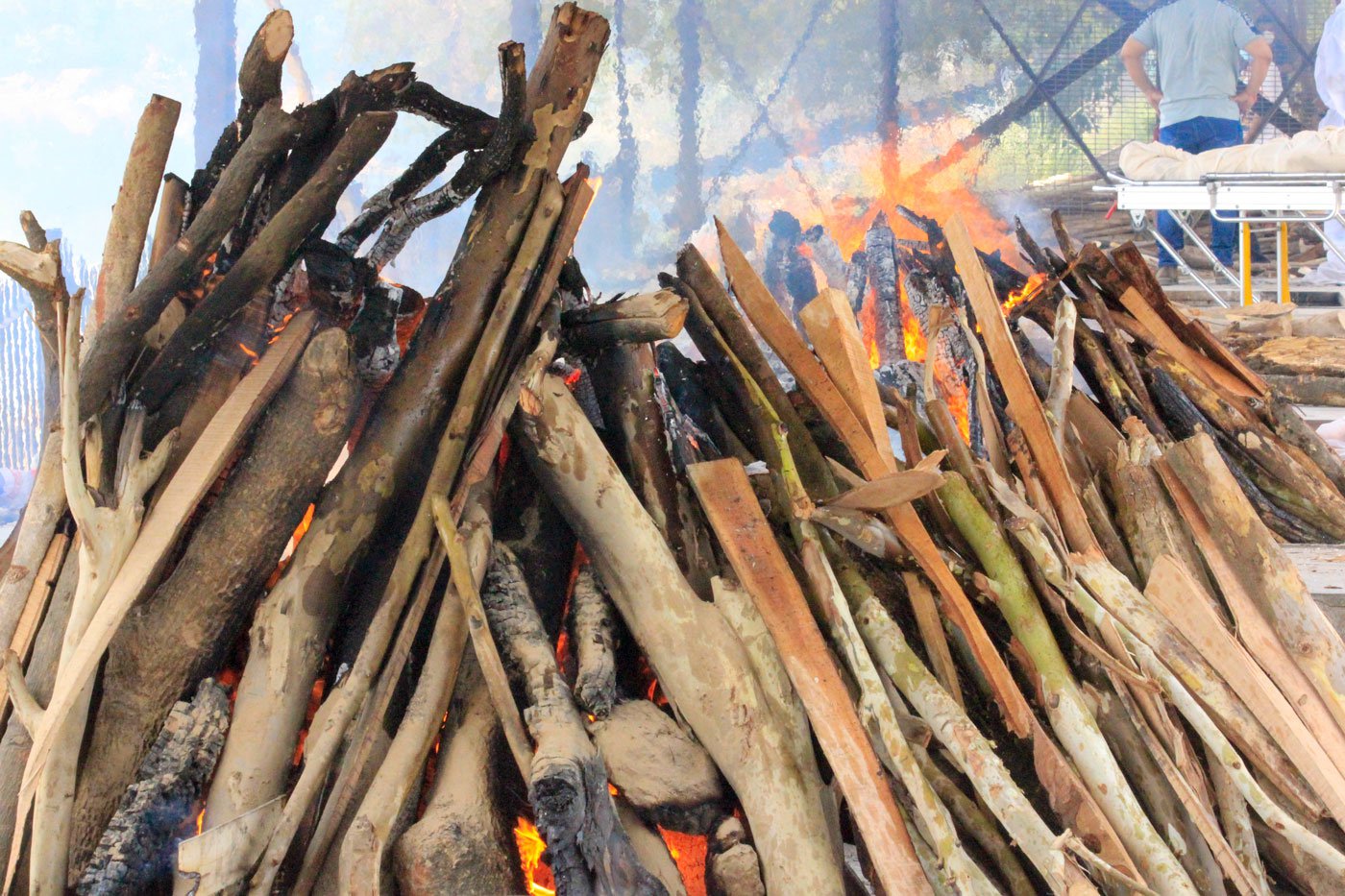
Left: The dead body of a Covid-positive patient resting on a stretcher in the crematorium premises. Right: A body burning on an open pyre at Nigam Bodh Ghat
“The handle of the furnace door was broken. We have fixed it with a bamboo stick,” said Raju Mohan. “We asked our supervisor to get the door repaired. He told us, ‘How can we get it fixed in the lockdown?’ We know that nothing will be done,” said Harinder.
They don’t even have access to a first aid box.
There were newer dangers now, like slipping on the floor because of ghee and water poured by family members before sending the body into the furnace. “It is not allowed. It is both unhygienic and risky, but people ignore the restrictions,” said Amar Singh, an official of Municipal Corporation of Delhi. He is one of seven MCD supervisors appointed during the pandemic to oversee the operations of Nigam Bodh Ghat.
The bodies that are received before 8 p.m. are cremated the same day, said Singh. Those arriving later had to wait until the next morning, without anyone attending to them. So the ambulance cost went up because night charges would get added, he said. “An immediate solution would be to run the furnace round the clock.”
But was that possible? “Why not?” said Singh. “When you roast a chicken in a tandoor, the tandoor remains intact. The furnaces here have the capacity to run for 24 hours. But the sanstha will not allow it.” Pappu disapproved the idea, saying, “The machine, like a human being, requires some rest.”
Both Singh and Pappu agreed there was a shortage of workers at the crematorium. “If something happened to any of them, the operations, already strained, would collapse,” said Singh, adding that the workers were not covered by insurance. Pappu’s considerations were slightly different. “If there were a few more workers like Harinder and me, it would ease things here, allowing us to get some rest,” he said.
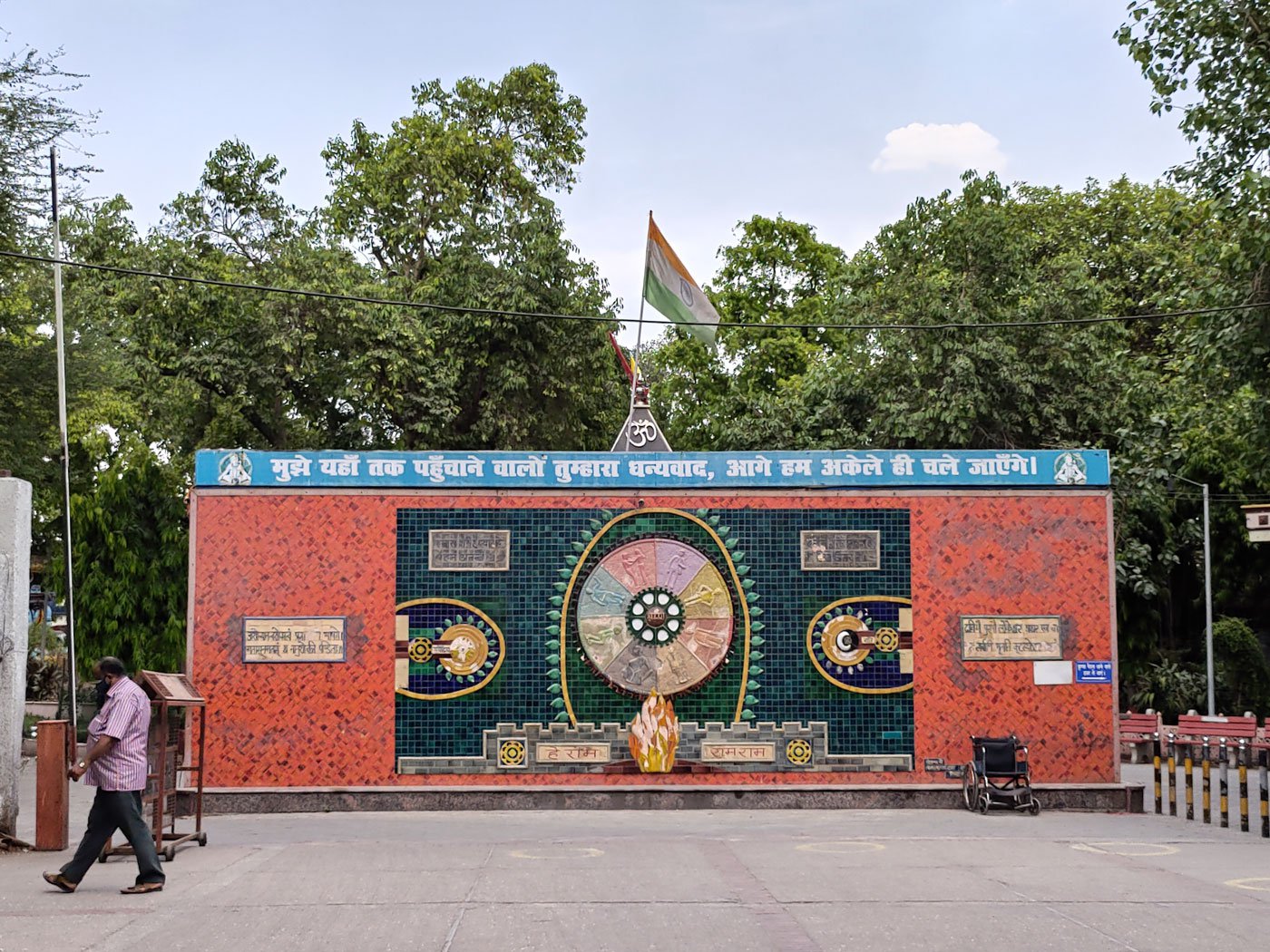
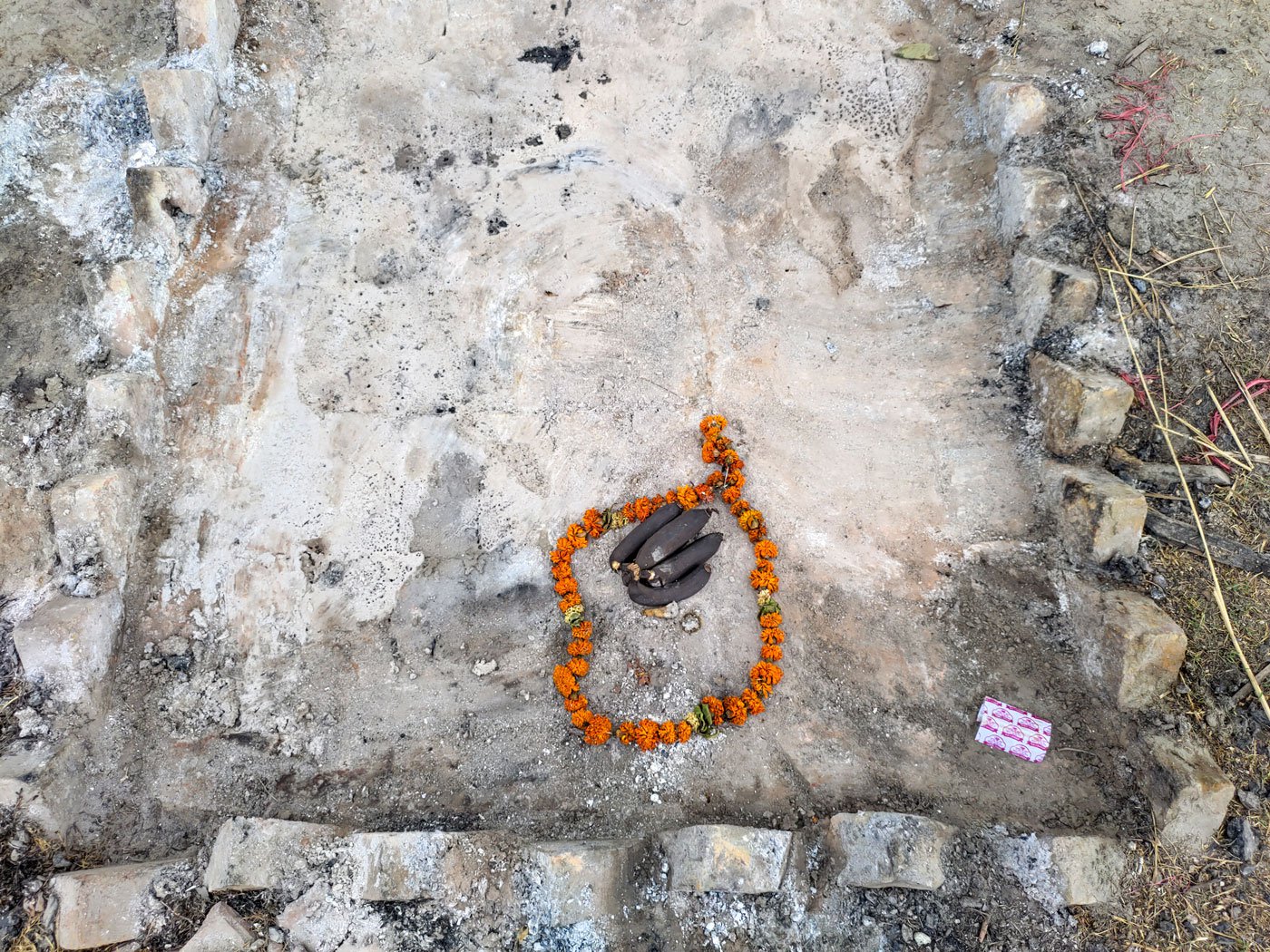
Left: The large mural at the entrance of Nigam Bodh Ghat. R ight: A garland of marigold flowers and dried bananas left on the ashes after cremation
When I asked Gupta what if something happened to any of them, he calmly said, “The remaining three will work in that case. Else we will bring in workers from outside.” The workers have incentives, he added, “It is not as if we don’t give them food. We do. We give them food, medicines and sanitisers.”
Later that day, when Harinder and his coworkers ate dinner in the small room, a fire was gnawing through a body in the furnace nearby. The workers had poured themselves some whisky. “We have to drink [alcohol]. Without it, we simply cannot survive,” explained Harinder.
Before the pandemic, they managed with three pegs of whisky (a peg is 60 ml) but now they had to stay drunk the whole day to do their job. “A quarter [180 ml] in the morning, same at lunch, then in the evening and a quarter after dinner. Sometimes, we drink after going back home as well,” said Pappu. “The good thing is the sanstha does not stop us. In fact, they go a step further and provide us with alcohol every day,” said Harinder.
Alcohol gives these 'lastline' workers a release from the pain and hard labour of burning a dead human being. “They are dead, but so are we because working here is tedious and exhausting,” said Harinder. “When I drink a peg and then see the bodies, I become sober,” added Pappu. “And when dust and smoke get stuck in our throats sometimes, the alcohol flushes it down.”
The moment of relief had passed. It was time for Pappu to go and attend to the two launde . “We also cry. We also get tears. We do,” he said, his voice full of sadness, his eyes moist. “But we have to hold on and protect our hearts.”
This story is part of a series of 25 articles on livelihoods under lockdown, supported by the Business and Community Foundation.
